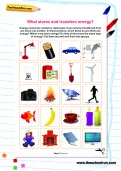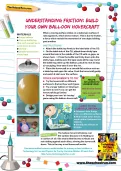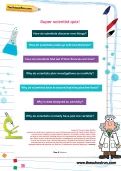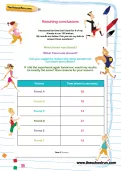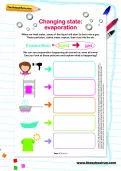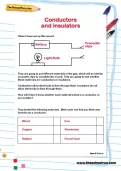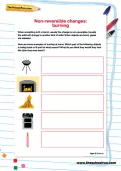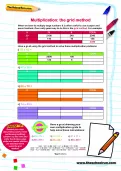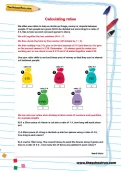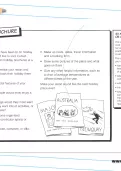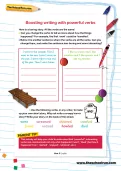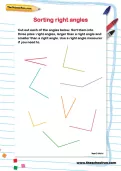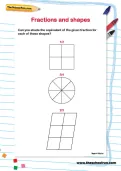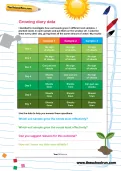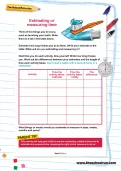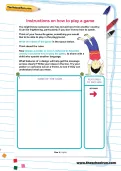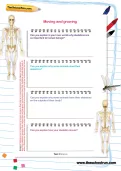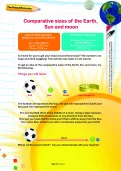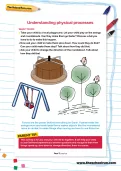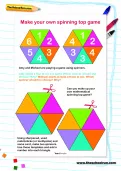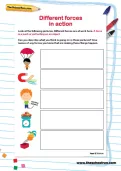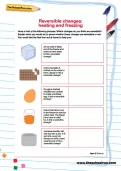A worksheet with pictures of the process of evaporation. Children need to write in the boxes what they think is happening in each picture.
or
Register to add to your saved resources
Already a subscriber? to view this content.
This worksheet will help your child experience the basic principles of forces such as pushing/pulling, gravity, and friction.
or
Register to add to your saved resources
Already a subscriber? to view this content.
This activity encourages your child to measure your kitchen at home and then calculate its perimeter and area.
or
Register to add to your saved resources
Already a subscriber? to view this content.
Use this worksheet to discuss conductors and insulators with your child. See if they can work out which materials will make the bulb light up and why.
or
Register to add to your saved resources
Already a subscriber? to view this content.
A worksheet to encourage children to think about how everyday objects change when they are lit or burnt.
or
Register to add to your saved resources
This worksheet clearly sets out the grid method, which is a simple way to multiply a two-digit number by another two-digit number.
or
Register to add to your saved resources
Already a subscriber? to view this content.
This worksheet describes how to work out ratio problems. It then gives various examples of real-life problems.
or
Register to add to your saved resources
What's your child's dream holiday destination? Their task is to write a leaflet advertising it to persuade people to book their holiday there. They'll need to understand holiday-brochure writing, select the right style and write persuasively. Can their writing convince you to visit?
or
Register to add to your saved resources
Already a subscriber? to view this content.
This activity will help your child identify powerful verbs and practise using them to improve their writing.
or
Register to add to your saved resources
Already a subscriber? to view this content.
This worksheet will enable children to differentiate between right angles, angles smaller than a right angle, and angles larger than a right angle. A fun visual activity.
or
Register to add to your saved resources
Already a subscriber? to view this content.
A worksheet with pictorial representations of equivalent fractions for your child to work out and colour in.
or
Register to add to your saved resources
Already a subscriber? to view this content.
A worksheet showing results of an investigation into how different soils affect the growth of plants.
or
Register to add to your saved resources
Already a subscriber? to view this content.
Ask your child to estimate and then accurately measure how long it takes to do everyday activities in order to practise measuring time.
or
Register to add to your saved resources
Already a subscriber? to view this content.
This worksheet encourages your child to write instructions on how to play a game for a child who does not speak English.
or
Register to add to your saved resources
Already a subscriber? to view this content.
A list of questions to prompt children into thinking further about moving and growing and the importance of the skeleton.
or
Register to add to your saved resources
An activity for your child to try at home to help them get a clear understanding of the comparative sizes of and distances between the Earth, Sun and moon.
or
Register to add to your saved resources
Already a subscriber? to view this content.
This worksheet will help your child to use first-hand experience to answer questions and to recognise that when things speed up, slow down or change direction, there is a cause.
or
Register to add to your saved resources
This activity encourages your child to explore probability, by answering questions on some given results and then making their own spinning top.
or
Register to add to your saved resources
Already a subscriber? to view this content.
This worksheet has pictures to prompt children into thinking about the different forces that are at work in everyday life. It also gives another sheet with explanations of the different forces.
or
Register to add to your saved resources
Already a subscriber? to view this content.
Some examples of changes made by heating or freezing. Children need to work out whether these are reversible or non-reversible. Some can be tested at home.
or
Register to add to your saved resources
Already a subscriber? to view this content.
